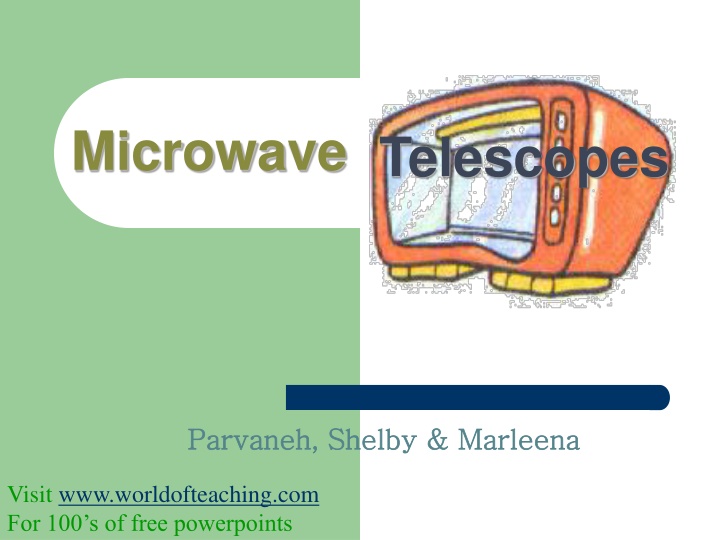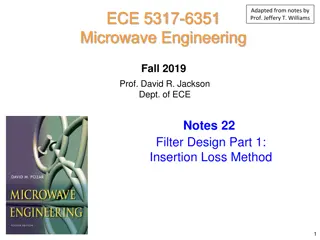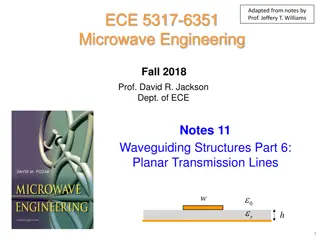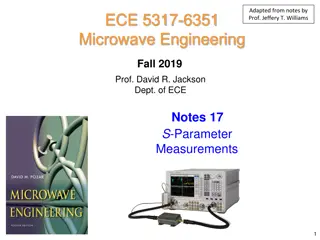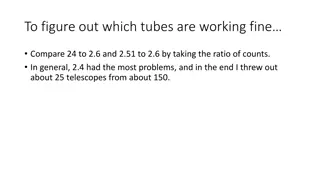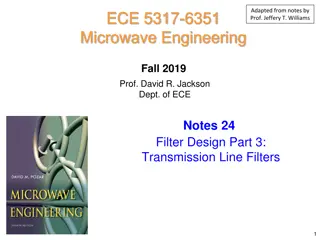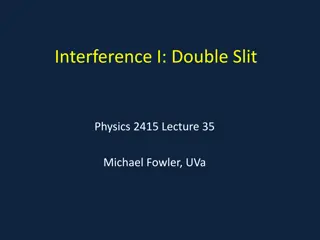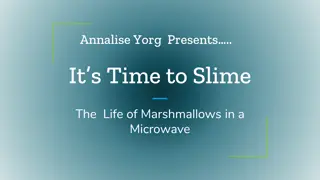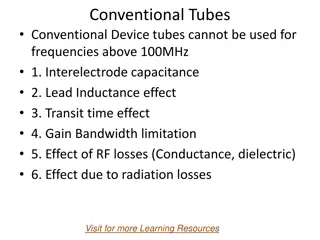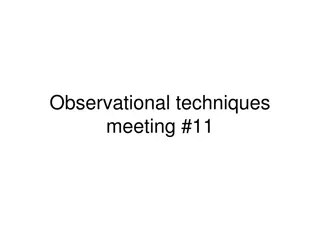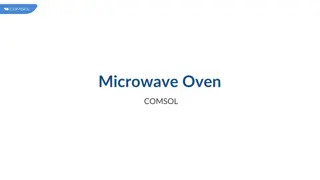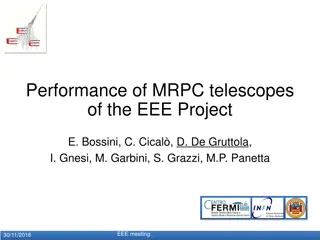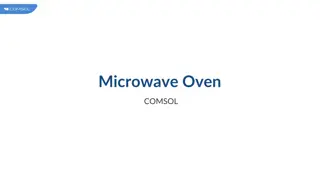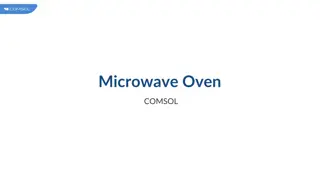Microwave Telescopes
Microwave telescopes play a crucial role in understanding the universe's origins, from detecting cosmic microwave background radiation to unraveling mysteries like the Big Bang theory. These telescopes have been instrumental in studying the geometry, expansion rate, and age of the universe, shedding light on dark matter and energy. The history of microwave telescopes, including their discovery for domestic use and their role in the Big Bang model, showcases their significance in unraveling cosmic mysteries.
Download Presentation

Please find below an Image/Link to download the presentation.
The content on the website is provided AS IS for your information and personal use only. It may not be sold, licensed, or shared on other websites without obtaining consent from the author.If you encounter any issues during the download, it is possible that the publisher has removed the file from their server.
You are allowed to download the files provided on this website for personal or commercial use, subject to the condition that they are used lawfully. All files are the property of their respective owners.
The content on the website is provided AS IS for your information and personal use only. It may not be sold, licensed, or shared on other websites without obtaining consent from the author.
E N D
Presentation Transcript
Microwave Telescopes Parvaneh, Shelby & Marleena Parvaneh, Shelby & Marleena Visit www.worldofteaching.com For 100 s of free powerpoints
Discovery (domestic use) Microwaves have wavelengths range from centimeters to those closer to a foot in length. Longer are for heating food. Shorter waves Doppler radar Microwaves were first utilized by British the 1940s during WWII. Sir John Randall and Dr. H. A. Boot, invented a device called a magnetron (Radar) using microwaves to detect Nazi warplanes. 1945, examining the magnetron, Percy Spencer s candy bar melted Product was marketed, thank goodness Percy was a chocolate lover! www.sabers.org/STELLA%20CAND Y%20BAR.JPG
Cosmic Microwave Background (CMB) 1960's at scientists at Bell Laboratories detected background noise using a special low noise antenna. This static noise came from every direction and did not vary in intensity. The scientists soon realized they had discovered the cosmic microwave background radiation. This radiation, which fills the entire Universe, is believed to be a clue to it's beginning, something known as the Big Bang.
Big Bang Model Universe was once much smaller, hotter, and denser Based off of Einstein s theory of general relativity Expansion of the universe 1929 Lightest elements Deuterium, helium, lithium CMB oldwww.internet2.edu/apps/html/archives.html
What the CMB tells us about the Universe The geometry of the universe Whether the universe will expand or collapse How much matter there is in the universe Amount and nature of dark matter and energy Expansion rate of the universe Age of the universe The origins of galaxies and galaxy clusters
Origins of the CMB Universe cooled as expanded became less dense Density variations affected temp. of photons Dense regions = hot spots in CMB 300,000 years cooled enough to form atoms Photons traveled through form relic radiation Gravitational collapse 1 billion years Created galaxies
Brief History and COBE The cosmic microwave background radiation is a remnant of the Big Bang and the fluctuations are the imprint of density contrast in the early universe. DMR Receiver COBE (November 18, 1989- 1993) Frequent observations were made over 6 mo. periods for 4 years. DIRBE (Diffuse InfraRed Experiment) FIRAS (Far-InfaRed Absolute Spectrophotometer) DMR (Differential Microwave Radiometers)
Differential Microwave Radiometer COBE s findings at different levels of contrast: Variations in intensity of the cosmic microwave background, show the post-Big Bang matter and energy distribution. Uniformity / Isotropic CMB (top) temperature of CMB 2.728 K Black body curve (middle) One hot and cold spot in the sky coming from our Solar System's motion through the galaxy. 3.353 mK Density Ripples (bottom) Further contrast with our local motion removed. hot red stripe through the center marks the galactic plane and above and below are variations in microwaves of the CMB! 18 K
What are Microwaves used for? Heating, transmitting information, remote sensing Shorter microwaves used for remote sensing Doppler radar Active remote sensing system Microwaves pierce through all cloud covering of earth Satellite images http://imagers.gsfc.nasa.gov/ems/micro.html
Archeops Balloon Born Telescope Aims High quality CMB data with unmatched sky coverage Competitive results on CMB anisotropy measurements Testbed for data analysis to be used in PLANCK http://journal.archeops.org/First_results/index.html
Boomerang Balloon born telescope Dec. 29, 1998 Jan. 9, 1999 10.5 days around antarctica 120,000 ft 1.2 m primary mirror Measured sky at 4 frequencies 90, 150, 240, 400 Covered 1800 square degrees (3% of sky) http://cmb.phys.cwru.edu/boomerang/press_im ages/cmbfacts/cmbfacts.html
Cosmic background Imager radio telescope to study CMB radiation Measure the statistical properties on angular scales from 5 arc minutes to one degree 13 element interferometer Field of view 44 arcmin Resolution 4.5-10 arcmin Looks at foreground Unresolved sources measured by 40 m telescope in Owens Valley Radio Observatory http://www.astro.caltech.edu/~tjp/C BI/pictures/cbi-frontview.html
DASI Degree Angular Scale Interferometer http://astro.uchicago.edu/dasi/ 13 elemental interferometer Measure temp and angular power spectrum Sampled over l range of 160-170 or .25-1.15 degrees Mount includes rotation of aperture plane along line of sight
WMAP Wilkinson Microwave Anisotropy Probe Launched 2001 to map CMB radiation with higher resolution, sensitivity, and accuracy than COBE http://map.gsfc.nasa.gov/m_mm/sg_earlyuniv.html
MAXIMA Millimeter Anisotropy eXperiment Imaging Array angular power spectrum with a unique set of "acoustic peaks" between the angular scales of 2 degrees and 10' can provide precise estimates of cosmological constants http://cosmology.berkeley.edu/group/ cmb/image/maxima_map.gif
Plank Part of the first European mission to study the birth of the Universe Construction to be finished in 2005 Launched in the same rocket with Herschel in 2007 Will observe the Cosmic Microwave Background (left over radiation from the Big Bang)
PLANK Click to get full image of FIRST/PLANCK http://spaceflightnow.com /news/n0006/13planck/ http://sci.esa.int/science- e/www/object/index.cfm?fobjectid=34875 http://www.dsri.dk/planck/
The South Pole Telescope (SPT) An 8-meter precision submillimeter-wave telescope Distant galaxy clusters through detection of their Sunyaev-Zel dovich effect (SZE) Dark Energy will be observed in great detail 1,000 Bolometers (heat detectors) measure the temperature differences up to 10 millionths of a degree Mapping large areas of the sky will be very beneficial to modern astronomers
The South Pole Telescope http://astro.uchicago.edu/spt/ http://www.spaceflightnow.com/news/n0301/29polescope/
The Very Small Array (VSA) Will be built as an Inferometer, due to the changing weather patterns and the basic noise of the instruments that are experienced Uses radio signals received by each antenna Construction finished in 1999 now in Tenerife http://www.mrao .cam.ac.uk/tele scopes/vsa/
Very Small Array Array top view www.mpifr-bonn.mpg.de/.../ teleskope/vsa_art1.jpg www.jb.man.ac.uk/tech/ technology/array-top.jpg www.mrao.cam.ac.uk/ telescopes/vsa/ext-array.jpg
Bibliography http://www.archeops.org/ http://cmb.phys.cwru.edu/boomerang/ http://www.astro.caltech.edu/~tjp/CBI/ http://astro.uchicago.edu/dasi/ http://map.gsfc.nasa.gov/ http://cosmology.berkeley.edu/group/cmb/index.html http://imagers.gsfc.nasa.gov/ems/micro.html Comins & Kaufmann III, Discovering the Universe; 2003 http://aether.lbl.gov/www/projects/cobe/COBE_Home/DMR_Images.html http://map.gsfc.nasa.gov/m_uni/uni_101bbtest3.html http://nacho.princeton.edu/fowler/Talks/Brazosport_2001/slide30.html http://www.ideafinder.com/history/inventions/story068.htm
